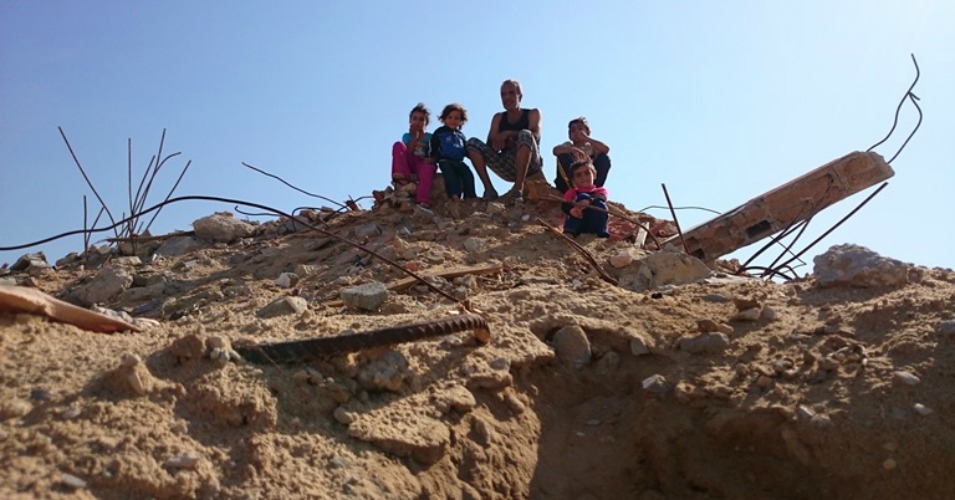
by Jen Marlow
Rubble. That’s been the one constant for the Awajah family for as long as I’ve known them.
Four months ago, their home was demolished by the Israeli military — and it wasn’t the first time that Kamal, Wafaa, and their children had been through this. For the last six years, the family has found itself trapped in a cycle of destruction and reconstruction; their home either a tangle of shattered concrete and twisted rebar or about to become one.
I first met the Awajah family in August 2009, in the tent where they were living. I filmed them as they told me what had happened to them eight months earlier during the military invasion that Israel called Operation Cast Lead and said was a response to rocket fire from the Gaza Strip.
I had no intention of making a film when I went to Gaza, but after hearing the family’s story, I knew I had to. I returned again in 2012 and have continued to stay in touch in the years since, realizing that the plight of the Awajahs opened a window onto what an entire society was facing, onto what it’s like to live with an interminable war and constant fear. The Awajahs’ story shines a spotlight on what Palestinians in Gaza have endured for years on end.
What stuck with me most, however, was the demand of the Awajah children regarding the reconstruction of their new home in 2012: they insisted that the house have two doors.
What The Awajahs Saw
In separate interviews in 2009, Wafaa and Kamal Awajah told me the same story, each breaking down in tears as they offered me their memories of the traumatic events that had taken place eight months earlier — a night when they lost far more than a home. The next day, a still grief-stricken Wafaa walked me through her recollections of that night, pointing out the spot where each incident had taken place.
On January 4th, as Operation Cast Lead’s ground campaign began, the Awajah family was at home. Wafaa’s eldest daughter, 12-year-old Omsiyat, woke her up at around 2 am. “Mom,” said Omsiyat, “soldiers are at the door.” Wafaa jumped out of bed to look. “There are no soldiers at the door, honey,” she reassured her daughter. When Omsiyat insisted, Wafaa looked again, and this time she spotted the soldiers and tanks. She lit candles in the window so that the Israeli troops would know that a family was inside.
Suddenly, the ceiling began to crumble. Wafaa, Kamal, and their six children fled, as an Israeli military bulldozer razed their home. No sooner had they made it outside than the roof collapsed. As tank after tank rolled by, the family huddled under an olive tree next to the house. When dawn finally broke, they could examine the ruins of their house.
Just as the Awajahs were trying to absorb their loss, Wafaa heard nine-year-old Ibrahim scream. He had been shot in the side. As more gunfire rang out, Kamal scooped up the injured boy and ran for cover with the rest of the family. Wafaa was hit in both hips, but she and five of the children managed to take shelter behind a mud-brick wall. From there, she saw Kamal, also wounded, lying in the middle of the road, Ibrahim still in his arms.
Israeli soldiers approached her husband and son on foot, while Wafaa watched, and –according to what she and Kamal both told me — without warning, one of them shot Ibrahim at close range, killing him. He may have assumed that Kamal was already dead. Despite Wafaa and Kamal’s wounds, the family managed to get back to their wrecked home, where they hid under the collapsed roof for four days with no food or clean water, until a passing family with a donkey cart took them and Ibrahim’s body to a hospital in Gaza city.
As far as I know, the Israeli military never investigated the incident. In fact, only a handful of possible war crimes during Operation Cast Lead were ever investigated by Israel. Instead of an official inquiry, the Awajahs were left with a dead son, grievous physical wounds that eventually healed, psychological ones that never will, and a home reduced to pile of rubble.
(You may also click here to view the video on Vimeo if your browser is having trouble loading the video on this page.)
Life Goes On
When I met them eight months later, the Awajahs were struggling to rebuild their lives. “What’s hardest is how to offer safety and security for my children,” Kamal told me. “Their behaviors are not the same as before.”
Wafaa pointed to three-year-old Diyaa. “This boy is traumatized since the war,” she said. “He sleeps with a loaf of bread in his arms. If you try to take it from him, he wakes up, hugs it, and says, ‘It’s mine.’”
“What you can’t remove or change is the fear in the children’s eyes,” Kamal continued. “If Diyaa sees a bulldozer, he thinks it’s coming to destroy a house. If he sees a soldier, whether an Israeli or Arab soldier, he thinks the soldier wants to kill him. I try to keep them away from violence, but what he experienced forces him to release his fear with violence. When he kisses you, you can feel violence in his kiss. He kisses you and then pushes you away. He might punch or slap you. I am against violence and war in any form. I support peaceful ways. That’s how I live and raise my children. Of course, I try to keep my children from violence, and help them forget what happened to them, but I can’t erase it from their memory. The memories of fear are engraved in their blood.”
I thought about Kamal’s words as I filmed Diyaa and his five-year-old sister Hala scrambling onto the rubble of their destroyed home — their only playground — squealing with glee as they rolled bullet casings and shrapnel down the collapsed roof.
What moved me deeply was the determination of Kamal and Wafaa to create a future for their surviving children. “Yes, my home was destroyed, my life was destroyed, but this didn’t destroy what’s inside me,” Kamal said. “It didn’t kill me as Kamal. It didn’t kill us as a family. We’re living. After all, we must continue living. It’s not the life we wanted, or had, but I try to provide for my children what I can.”
The Fragility of Hope
In 2012, I returned to Gaza and to the tent in which the Awajah family was still living. It was evident that the trauma of their experience in 2009 — along with the daily deprivation and lack of security and freedom that characterize Gaza under siege — had taken a toll. “I had thought that those were the most difficult days of my life,” Kamal said, “but I discovered afterwards that the days which followed were even more difficult.”
In 2009, Kamal told me that the war hadn’t fundamentally changed him. Now, he simply said, “I lost myself. The Kamal before the war does not exist today.” He spoke of the screams of his children, waking regularly from nightmares. “The war is still chasing them in their dreams.”
Most painful for Kamal was his inability to help his children heal. His despair and feelings of helplessness had grown to the point where he had become paralyzed with severe depression. “I tried and I still try to get us out of the situation we are in — the social situation, the educational situation for the children, and the mental situation for me and my family.” But their situation, he added, kept getting worse.
My 2012 visit, however, came during a rare moment of hope. After nearly four years, the Awajah family was finally rebuilding their home. Trucks were delivering bags of cement; gravel-filled wheelbarrows were being pushed onto skids; wooden planks were being hammered down. In 2009, I had filmed Diyaa and Hala playing on the rubble of their destroyed house. In 2012, I filmed them climbing and jumping on the foundation of their new home.
“I am building a house. It is my right in life for my children to have a house,” Kamal said. “I call it my dream house, because I dream that my children will go back to being themselves. It will be the first step to shelter me and my children, away from the sun and the heat and tents, our homelessness. The biggest hope and the biggest happiness I have is when I see my children smiling and comfortable… when they sleep without nightmares.” Kamal added, “I can’t sleep because of my fear over them.”
For Wafaa, while the new home represented hope for their future, its construction also triggered flashbacks to that night of the bulldozer. As she told me, “Bulldozers and trucks bringing construction material came at night, and, at that moment, it was war again. When I saw the bulldozers and the trucks approaching with big lights, my heart fell between my feet. I was truly scared.”
Planning for the new house also provided Wafaa and Kamal with a poignant reminder of the fragility of hope in Gaza. “The children say to make two doors to the house,” Wafaa told me. “One [regular] door and the other door so when the Israelis demolish the house, we can use it to escape. We try to comfort them and tell them nothing like this will happen, but no, they insist on us making two doors. ‘Two doors, Daddy, one here and one there, so that we can run away.’”
The Gaza War of 2014
After my 2012 visit, I periodically contacted the Awajah family. Construction was proceeding in fits and starts, Kamal told me, due to shortages of materials in Gaza and their lack of financial resources. Finally, however, in the middle of 2013 the home was completed and as the final step, glass for the windows was installed in February 2014.
Five months later, in July, the most recent Israeli assault on Gaza began. I called the Awajah family right away.
“The children are frightened but okay,” Wafaa told me.
The Israeli army had warned their neighborhood to evacuate and they were now renting a small apartment in Gaza City. During a humanitarian ceasefire, Kamal was able to return to their house: it had been demolished along with the entire neighborhood.
When I spoke to the Awajah family at the end of September, Kamal told me that rent money had run out. Seeking shelter at a United Nations Relief and Works Agency (UNRWA) school wasn’t a viable option, he said, because there were already so many families packed into each room. The Awajahs were back in a tent next to the rubble of their twice-destroyed home.
The family’s situation is far bleaker than in 2009. Then they were able to tap into an electricity source and there was a communal outhouse for all the tent-dwelling families in the area. This time, Kamal said, the area near their house was entirely deserted: no water tank, electricity, outhouse, gas, or stove for cooking. Their only possessions were the few items of clothing they managed to take with them when they fled. They were sleeping on the ground, he said, no mattresses or blankets to ward off the cold, only the nylon of the tent beneath them. The children had been walking several kilometers to fill jugs with water until villagers who lived nearby made their wells available for a few hours a day.
Wafaa told me that she was cooking on an open fire, using scrap wood scavenged from the remnants of her house. For the first week, the children returned home from school every day and, surrounded by nothing but rubble, began to cry. Seventeen-year-old Omsiyat briefly took the phone. Her typically warm and open voice was completely flat, no affect whatsoever.
Worse yet, Kamal still owes $3,700 for the construction of their previous house. Though the home no longer exists, the debt does. “We are drowning,” Wafaa said.
(You may also click here to view the video on Vimeo if your browser is having trouble loading the video on this page.)
Drowning in Gaza
The Awajahs aren’t the only ones in Gaza who are drowning. The true horror of their repeated trauma lies in the extent to which it is widespread and shared. Nine-year-old Ibrahim Awajah was one of 872 children in Gaza killed in the 2009, 2012, and 2014 wars combined, according to statistics gathered by theUnited Nations Office for the Coordination of Humanitarian Affairs andB’tselem, an Israeli human rights organization. (There was also one Israeli child killed by mortar fire in that period.)
The flat affect in Omsiyat’s voice reflects the assessment of the United Nations Children’s Fund that nearly half of the children in Gaza are in urgent need of psychological help. And Kamal’s desire not to move into a communal shelter is understandable, given that 53,869 displaced people still remain crowded into 18 UNWRA schools. According to Shelter Cluster, an inter-agency committee that supports shelter needs for people affected by conflict and natural disaster, the Awajah family’s house is one of 18,080 homes in Gaza that were completely demolished or severely damaged in the 2014 war alone. A further 5,800 houses suffered significant damage, with 38,000 more sustaining some damage.
Shelter Cluster estimates that it will take 20 years for Gaza to be rebuilt — assuming that it does not face yet another devastating military operation. As the last six years indicate, however, unless there is meaningful political progress (namely, the ending of the Israeli siege and ongoing occupation), further hostilities are inevitable. It is not enough that people in Gaza be able to rebuild their houses yet again. They need the opportunity to rebuild their lives with dignity.
Kamal Awajah said as much. “I don’t ask anyone to build me a home for the sake of charity. That’s not the kind of help we want. We need the kind of help that raises our value as human beings. But how? That’s the question.”
There seem to be no serious efforts on the horizon to address Kamal’s question, which has at its core an insistence on recognizing the equal value of Palestinian humanity. As long as that question remains unanswered and the fundamental rights of Palestinians continue to be denied, the devastating impact of repeated war will continue for every family in Gaza and the terrifying threat of the next war will always loom. The Awajah children have every reason to insist that their future home be constructed with two doors.









